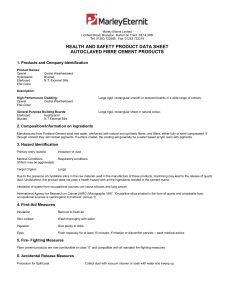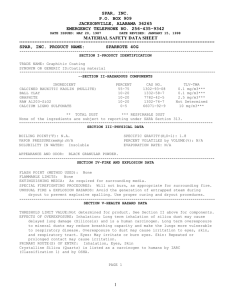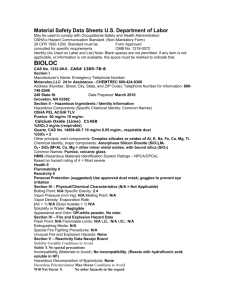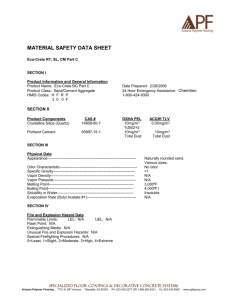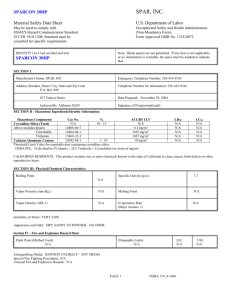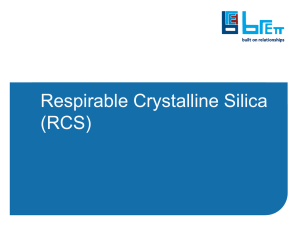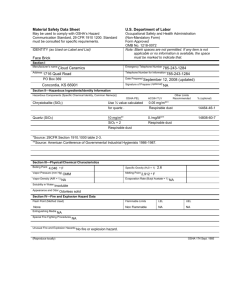MSDS - Anchor Bay Construction Products Limited
advertisement
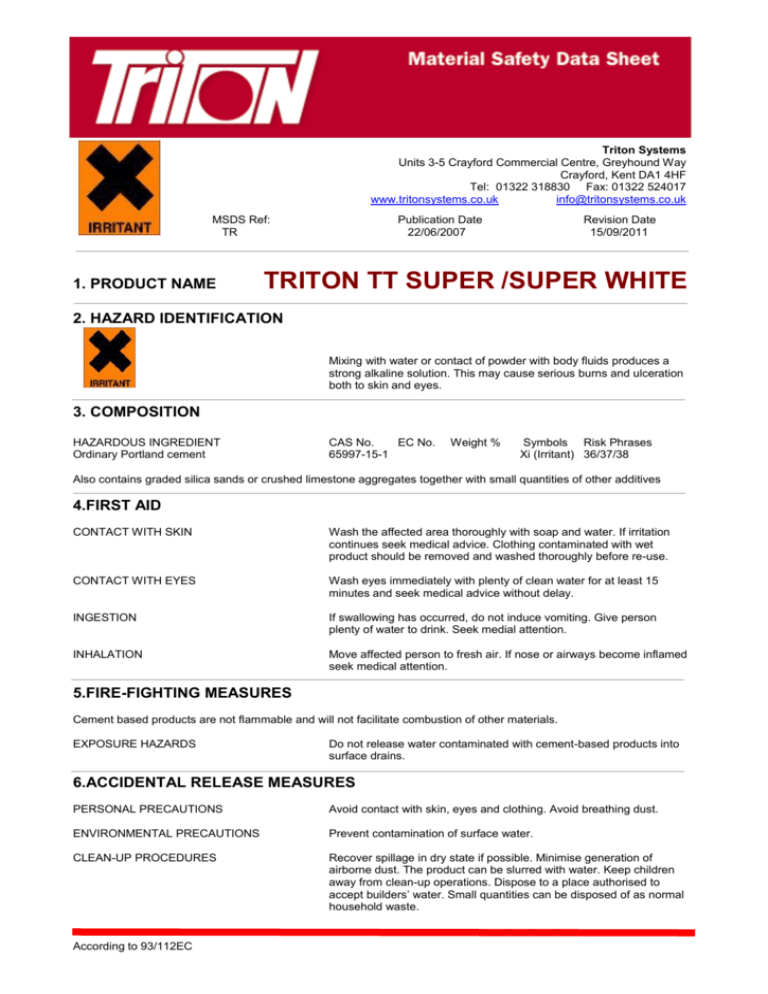
Triton Systems Units 3-5 Crayford Commercial Centre, Greyhound Way Crayford, Kent DA1 4HF Tel: 01322 318830 Fax: 01322 524017 www.tritonsystems.co.uk info@tritonsystems.co.uk MSDS Ref: TR 1. PRODUCT NAME Publication Date 22/06/2007 Revision Date 15/09/2011 TRITON TT SUPER /SUPER WHITE 2. HAZARD IDENTIFICATION Mixing with water or contact of powder with body fluids produces a strong alkaline solution. This may cause serious burns and ulceration both to skin and eyes. 3. COMPOSITION HAZARDOUS INGREDIENT Ordinary Portland cement CAS No. EC No. 65997-15-1 Weight % Symbols Risk Phrases Xi (Irritant) 36/37/38 Also contains graded silica sands or crushed limestone aggregates together with small quantities of other additives 4.FIRST AID CONTACT WITH SKIN Wash the affected area thoroughly with soap and water. If irritation continues seek medical advice. Clothing contaminated with wet product should be removed and washed thoroughly before re-use. CONTACT WITH EYES Wash eyes immediately with plenty of clean water for at least 15 minutes and seek medical advice without delay. INGESTION If swallowing has occurred, do not induce vomiting. Give person plenty of water to drink. Seek medial attention. INHALATION Move affected person to fresh air. If nose or airways become inflamed seek medical attention. 5.FIRE-FIGHTING MEASURES Cement based products are not flammable and will not facilitate combustion of other materials. EXPOSURE HAZARDS Do not release water contaminated with cement-based products into surface drains. 6.ACCIDENTAL RELEASE MEASURES PERSONAL PRECAUTIONS Avoid contact with skin, eyes and clothing. Avoid breathing dust. ENVIRONMENTAL PRECAUTIONS Prevent contamination of surface water. CLEAN-UP PROCEDURES Recover spillage in dry state if possible. Minimise generation of airborne dust. The product can be slurred with water. Keep children away from clean-up operations. Dispose to a place authorised to accept builders’ water. Small quantities can be disposed of as normal household waste. According to 93/112EC 7.HANDLING AND STORAGE HANDLING PRECAUTIONS When handling bags of cement-based products most of which weigh 25kg, due regard should be paid to Manual Handling Regulations 1992. Some bags may have a small amount of cement dust on their outer surface. Appropriate personal protection should be used whilst handling. STORAGE INFORMATION Bags should be stacked in a safe and stable manner. Store in dry conditions. 8.EXPOSURE CONTROLS/PERSONAL PROTECTION TECHNICAL PROTECTIVE MEASURES No special measures required. EXPOSURE LIMITS Occupational Exposure Standard (OES) Limits 8 hour TWA: 10mg/m³ total inhalable dust, 5mg/m³ respirable dust All Triton cement based products contain powders, which if handled carelessly can raise dust. The personal exposure to such dusts (cement, silica sand, crushed limestone etc.) must be kept below 10mg/m³ 8 hour TWA total inhalable dust and 5mg/m³respirable dust. Some of the cement based products contain microsilica form of silica. The personal exposure level to amorphous silica must be kept below 6mg/m³ 8 hour TWA total inhalable dust and 3mg/m³ respirable dust. Some sands and other fillers may contain small quantities of respirable silica for which the personal exposure must be kept below 0.4mg/m³ 8 hour TWA. If care is taken not to raise dust and the exposure levels for nuisance dusts are not exceeded, the levels for respirable silica should be very low. Applying Occupational Exposure Standards EH40/95 Sections 40 and 4.1. Also see Dust: General Principles of Protection HSE Guidance Note EH44 Rev 1991. Occupational Exposure Standards Limits – 8 hour TWA, reference period from Guidance Note EH40/95, Table 2. AMORPHOUS SILICA: Total inhalable dust: Respirable dust: 6mg/m³ 3mg/m³ PORTLAND CEMENT: Total inhalable dust: Respirable dust: 10mg/m³ 5mg/m³ Suitable respiratory protection should be worn to ensure that personal OES is not exceeded. If care is taken not to raise dust during handling, the use of respirators is not normally necessary. Wear suitable gloves. Suitable goggles or face protection should be worn wherever there is a risk of product powder or product/water mixture entering the eye. Wear overalls and closed footwear. 9.PHYSICAL AND CHEMICAL PROPERTIES PHYSICAL STATE Particulate PARTICAL SIZE 5 – 6000 pm Ph of wet cement 12 - 14 10. STABILITY AND REACTIVITY Stable under normal room temperature storage conditions. Bags will set solid if continually soaked with water. According to 93/112EC 11.TOXICOLOGICAL INFORMATION EYE CONTACT Cement constituent is severe eye irritant. Mild exposures can cause soreness. Gross exposures or untreated mild exposures can lead to chemical burning and ulceration of the eye. SKIN CONTACT The powder or product/water mixture may cause irritation, contact dermatitis or allergic dermatitis and/or burns. INHALATION Inhalation of the powder may cause inflammation of mucous membranes. INGESTION The swallowing of small amounts of product or product/water mixtures is unlikely to cause any significant reaction. Larger doses may result in irritation to the gastro intestinal tract. 12.ECOLOGICAL INFORMATION AQUATIC TOXICITY RATING LC50 aquatic toxicity rating has not been determined. The addition of any cement based product to water may, however, cause the pH to rise and therefore may be toxic to aquatic life in some circumstances. No other specific information available. 13.DISPOSAL CONSIDERATIONS Dispose of empty bags or surplus product to a place authorised to accept builders’ waste. Keep out of reach of children. Small numbers of bags can be disposed of as normal household wastes. 14. TRANSPORT INFORMATION Classification for transport not required. 15. REGULATION INFORMATION SYMBOLS: Xi Irritant RISK PHRASES R36/37/38: Irritating to eyes, respiratory systems and skin. SAFETY PHRASES S22 : Do not breathe dust. S28 : After contact with skin, wash immediately with plenty of soap and water. S26 : In case of contact with eyes, rinse immediately with plenty of water and seek medical attention. S24/25: Avoid contact with skin and eyes. S37/39: Wear suitable gloves and eye/face protection. Keep out of reach of children. READ ALL PRECAUTIONS BEFORE USE The (COSHH) Control of Substances Hazardous to Health Regulations 1988 may apply to the use of this product at work. Engineering control of operator exposure must be used where reasonably practicable in addition to the following items of personal protective equipment. WEAR SUITABLE PROTECTIVE CLOTHING, gloves and eye/face protection. IN CASE OF CONTACT WITH EYES rinse immediately with plenty of water and seek medical advice. AFTER CONTACT WITH SKIN, wash immediately with plenty of clean water. KEEP OUT OF REACH OF CHILDREN. Refer to other relevant legislation such as the Health and Safety at Work etc Act (HSWA), THE Control of Substances Hazardous to Health Regulations (COSHH), the Environment Protection Act and the Control of Pollution Act. The information contained in this safety data sheet does not constitute the user’s own assessment of workplace risk as required by health and safety legislation. According to 93/112EC 16.OTHER INFORMATION The information contained in this data sheet is to the best of our knowledge accurate at the date of publication, but we cannot accept responsibility that it is sufficient or correct in all cases. The data contained herein does not constitute a specification. Such information is available from the technical data sheet for the product. Abbreviations: OES – occupational exposure standard. STEL – short-term exposure limit. LTEL – long term exposure limit. TWA – time weighted (8 hour) average. LEL – lower explosive limit. UEL – upper explosive limit. According to 93/112EC
